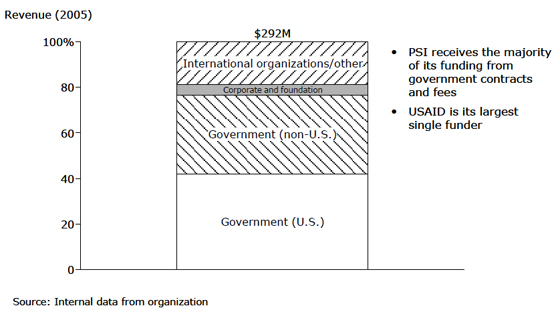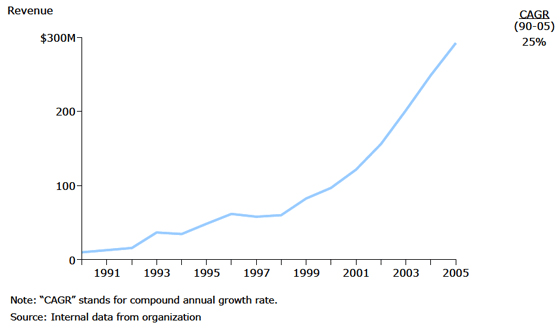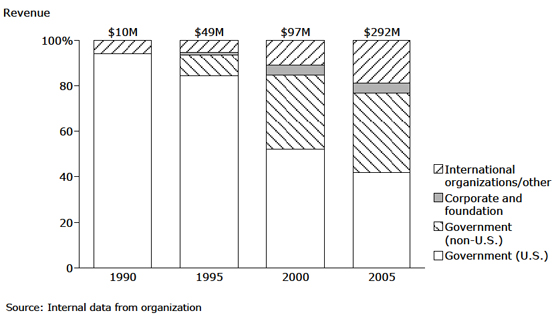Nike may have taken 'just do it' from us.
– Richard Frank, former President
Overview
Related Content
How Nonprofits Get Really BigOrganization Profiles from How Nonprofits Get Really Big
Founded in the early 1970s, Population Services International (PSI) addresses major public health problems in the developing world. For its first 16 years, the organization worked mostly in family planning (hence the name Population Services International). PSI's first HIV/AIDS prevention project—which promoted abstinence, fidelity and condoms—began in 1988. It added malaria, safe water, and nutrition to its portfolio in the 1990s.
PSI’s leaders believe that local governments cannot “do it all” when it comes to addressing the health problems of low-income and vulnerable populations in developing countries. In 60 such countries, PSI works to harness the effectiveness and efficiency of the private sector to fill the void. The organization deploys commercial marketing strategies to promote health products, services, and healthy behavior that enable low-income and vulnerable people to lead healthier lives. It sells products and services at subsidized prices, rather than giving them away, in order to motivate commercial sector involvement.
While PSI is able to subsidize the sale of many of its products through government funding, its skill in using market-based distribution and creating incentives for poor individuals to purchase its products has been the primary basis of its financial success. The organization gives considerable operating discretion to its country offices, while the central office negotiates grants and contracts, oversees data collection, and provides administrative support.
Founding date: Early 1970s
Revenue (2005): $292 million (worldwide)
Structure: Single organization
NCCS classification: International—Foreign Affairs
Services: Uses private sector techniques to improve health in the areas of malaria, safe water, family planning, and HIV/AIDS
Beneficiaries: Low-income, high risk populations in developing nations
Leadership (selected): Richard Frank, former President; Peter Clancy, President and Chief Executive Officer (acting); William Warshauer, Executive Vice President, Resources and Strategy; Sally Cowal, Senior Vice President; David Reene, Senior Vice President
Address: 1120 19th Street NW, Suite 600, Washington, DC, 20036
Website: www.psi.org

Growth Story
- Early 1970s – PSI is founded with a focus on reproductive health and family planning.
- Late 1970s - early 1980s – PSI transfers techniques from the private sector and develops expertise in marketing and product distribution.
- 1985 – PSI begins work with oral rehydration therapy, its first foray outside of family planning programs.
- 1988 – Richard Frank becomes chief executive officer. He broadens PSI’s programs to address HIV/AIDS prevention and emphasizes entrepreneurialism and measurement. USAID supplies 90% of PSI’s funding.
- Mid-1990s – PSI expands into malaria treatment and safe water.
- Early 2000s – PSI realizes large increases in revenue from other international organizations and from foreign governments as it diversifies away from U.S. government funding.
- 2004 – Family planning accounts for less than half of all PSI revenue. USAID provides 45% of its funding.
Revenue Trends
Revenue growth: PSI’s growth accelerated through the late 1990s and early 2000s as the organization expanded the health problems it addressed, the government agencies with which it worked, and the geographies it served.

Funding mix: PSI’s government funding sources have diversified over time as PSI has expanded beyond USAID to other government programs.

Actions That Helped Propel Growth in Funding
- Implemented best practices from the for-profit sector. Successfully implementing commercial marketing strategies has been at the heart of PSI’s growth.
- Stuck with its core capability. PSI pioneered the use of commercial marketing strategies in its field and continued to deepen this area of expertise.
- Took calculated risks. Investing in new geographies and unproven techniques propelled PSI’s growth. Its leadership team relied on the strength of the PSI model, their ability to assess risk, and the talent of their team to deliver on investments.
- Invested heavily in local staff. PSI began to invest heavily in staff under Richard Frank’s tenure to facilitate the organization’s rapid entry into new areas and to enable the devolution of authority to local areas where PSI leadership believed better decisions could be made.
- Measured religiously. PSI’s ability to demonstrate positive outcomes achieved at a low cost has been key to attracting governmental and major individual donors.
Funding Challenges
- Balancing the need for both entrepreneurialism and central control. PSI’s entrepreneurial culture makes the organization tick. At the same time, the organization’s overall growth has prompted an expansion of central administrative capacity and thus an influx of staff members with more traditional qualifications. Maintaining an entrepreneurial culture in this environment has been tricky.
- Holding funders’ off-mission pulls in check. PSI has developed terms to identify activities that are off-mission (“the mush”) or on-mission but inefficient (the “yuck”). At times the organization must conduct “mush” and “yuck” activities to maintain its funder relationships, but it actively manages the amount of work that falls into these two categories.
- Securing unrestricted funding. Unrestricted funding has been difficult for PSI to come by, making capacity-building investments difficult.

